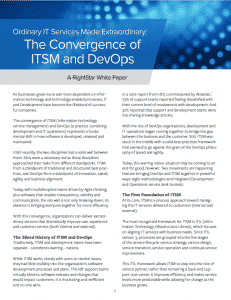Welcome to the third post in the Content Types series from Horizon Peak Consulting. As we roll out the 8 posts we have planned for this series, our goal is to help you see new opportunities for engaging your target audience and making more sales with your marketing content.
Ah, white papers — the magical unicorn of the content world.
Or at least, that’s what people think they are.
Here’s how I define a white paper:
A white paper is a long-form content asset that solves a problem for or educates the reader in a way that makes it obvious that your offering is the perfect solution.
It’s like a special report: It doesn’t push the sale, but rather it educates and persuades.
A white paper is typically designed as a downloadable PDF, but with today’s interactive content technology, you can also publish it as interactive web-based content.
Here’s a PDF example from ClearDATA.
White papers are often seen as “premium” content, and many companies go to lengths to earmark the right resources to create them (if only they’d put that much effort into their blog posts — but I digress). They’re high-value content assets — and they’re also amazing authority-builders and sales tools. Especially when …
- You’re selling a high-dollar, technical or complex offering
- Your customers have multi-level organizations, and multiple decision-makers are involved in a purchase
- The sales cycle is relatively long
A series of studies from Eccolo Media found that white papers rank as the most influential B2B content type, as well as the most frequently consumed content type (as compared to product data sheets, case studies, blogs, etc.) for both influencers and decision-makers.
Anecdotally speaking, white papers resonate well with executives. Get a bunch of high-level C-Suite execs in a room and ask them what they read — I can almost guarantee that white papers will come up in conversation.
These are all good things — but here’s what a lot of businesses don’t realize when they become blinded by the glory of white papers: They actually differ very little from e-books.
Both white papers and e-books are long-form, standalone assets that cover a topic in-depth. They both educate and/or solve a problem for the reader.
The biggest difference between white papers and e-books these days is tone. White papers tend to be more serious and professional in tone, while e-books tend to be lighter and a bit more casual.
White papers also tend to include more data than e-books — but even that has been changing in the last five years.
Are these hard and fast rules? No, of course not.
Frankly, the line between white papers and e-books is incredibly blurry these days. BUT, the value of a white paper is still perceived as higher than the value of an e-book — by businesses and their audiences.
When I’m giving my clients guidance on what type of content asset to create, it’s really the audience that leads us to the right choice. For industries such as technology, finance and healthcare, white papers are commonplace and expected.
So if I know the subject is complex, and we need to take a more serious tone in the writing, and the customer is in an industry where white papers are common and the decision-making process is involved, I would usually steer my client to produce a white paper instead of an e-book.
What is the real, bottom-line benefit of a white paper?
So you know what a white paper is, now — but maybe the benefits are still feeling a bit nebulous. Let’s dig in a bit more …
A white paper generates and engages leads
At the top of the sales funnel, a white paper captures leads by solving real problems for a target audience. And it keeps those new leads from exiting the funnel early by not pushing a heavy-handed sales pitch on them.
A well-written white paper educates, informs, engages, persuades … but it never forces a sales pitch on the reader.
That said, a white paper should still include contact information and a clear call-to-action (CTA) at the end. No content asset will give you a return on your investment if it doesn’t point people to how they can buy from you!
And think about it. White papers are often used by customers with multi-layered decision-making processes — so white papers get shared.
Here’s an example of how this might go down within a customer’s organization:
Jim, an IT guy at a small business, is trying to figure out how to create a plan for disposing of electronic waste. In his search online, he comes across this white paper from Iron Mountain. Excited, he forwards it to his boss with a note that says, “Next week in our team meeting, we need to make a plan for disposing of our e-waste. It’s a big security issue.”
Jim prints out copies of the white paper and hands them out to the five other people in the team meeting the following week. Once everyone has had a few minutes to scan the white paper, Jim presents his e-waste disposal plan. He cites some of the statistics from the white paper to underscore the importance of moving on this now.
Everyone agrees this is an important issue, and they like Jim’s plan. The plan gets approved right there in the team meeting.
Jim goes back to his desk and calls Iron Mountain about their IT asset disposal services.
You can see in this example that the white paper actually worked from the top of the funnel all the way to the bottom. It may have gotten Jim’s initial attention, but he continued to use it and share it as he and his colleagues weighed their options and made their decision.
So a white paper generates leads and keeps them engaged with your brand as they move from problem aware to solution aware to product aware.
A white paper builds authority for the author and publisher
By its very nature, a white paper is an expert content asset that builds trust and credibility. Because it’s meant for long-term use, a white paper most often focuses on an important, relatively evergreen topic (well, as evergreen as anything can be with the speed of technology innovation!) — then it educates and persuades without being heavily promotional.
Imagine a white paper as the Ivy League university seminar of the content world.
The author gains the stature of being the domain expert (the professor, if you will) while the publisher gains the prestige of giving him or her the platform (the university, if you will).
Take a look at this white paper from Showcase Workshop. Clearly Showcase is the expert at helping salespeople perform better in face-to-face sales situations. If you were a salesperson, wouldn’t you want to learn more from them — and then wouldn’t their unique expertise make you curious about their product?
A white paper is a sales enablement tool
Speaking of sales, white papers are great assets for salespeople, resellers and partners to keep on-hand, too.
- They’re high-value assets to send to cold leads.
- They’re handy leave-behinds for sales conversations.
- They can help build customer interest and answer questions about your solution.
- They’re fantastic conversation starters.
… and they keep working long after the rep has left the building.
A white paper educates other experts, including journalists and analysts
Attention from media and influencers can make a big difference in brand perception and lead generation. Don’t just sit back and wait for these folks to come to you — send them information that’s valuable to them and paints you as a knowledgeable, helpful thought leader.
- Deep background on a subject that’s important to the individual
- Your opinion on a hot topic
- Insight on an emerging or prevalent issue
- A special report on a study your company recently conducted
While other content types can accomplish this, the white paper format gives the information (and you and your company) more weight and credence.
Examples of White Papers in the Wild
The best way to get a sense for the white paper format is to see real-world examples. In addition to the few already mentioned in this article, here are three more to wet your whistle.
Pardot: Ten Tips for Accelerating Your Pipeline
RightStar: Ordinary IT Services Made Extraordinary
Tableau: BARC Data Preparation Study
The Most Authoritative Content Asset
A white paper can be one of the most powerful sales and marketing tools a company has.
While they to tend to work best in markets with longer sales cycles, and with businesses with more complex or technical offerings (like technology, finance and healthcare) the effectiveness of white papers is not limited to those industries.
Got enough insight into an issue to create a 2,500+-word content asset around it? A white paper might be the perfect format for you.
Talk to Jessica about your white paper project.





